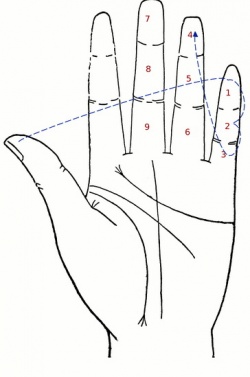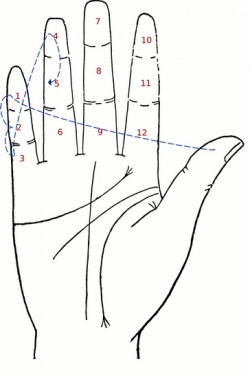How to chant a mantra 108 times without mala beads
Hindu mantras are traditionally repeated 108 times, using mala beads to count the repetition. Shaivites traditionally count on rudraksha beads, whereas Vishnavites us beads made from the stems of the tulsi plant.
There are times when it is useful to chant japa without mala beads. I recently read a facebook post that described a fairly complicated way of counting to 108 using your fingers. I found this method rather confusing, so I thought that it might be useful to describe a method that I use.
The method is based on counting the segments of each finger, pointing at each with the thumb on the same hand. Start by touching the tips of the thumb and the little finger of both hands together. Chant the mantra, then move the thumb of the right hand to point to the middle segment of the little finger. Chant again then point to the base of the little finger. After the third chant move the thumb to the tip of the next finger, then continue counting the segments of each fingers in turn as shown in the “right hand” picture.
Continue in this way until you reach the base of the index finger on the right hand. This time after chanting the mantra point the thumb of the right hand finger back at the tip of the index finger, and move the thumb of the left hand to point to the second (middle) segment of the index finger. You will now have chanted the mantra 12 times.
Continue counting with the right hand exactly as before. When you again reach the base of the index finger with your right hand thumb, again move the right hand thumb back to the tip of the index finger, and advance the thumb of the left hand to the base of the little finger. Continue in the same way, each time you finish counting on the right hand advancing the thumb of the left hand to the next finger/segment as shown in the left hand counting diagram.
Each advance of the left thumb represents 12 repetitions of the mantra. When you reach the point with the right thumb on the base of the index finger and the left thumb at the base of the middle finger you have completed 9 counts of 12 = 108 repetitions. This is the point where the next move would logically be to move the left thumb to the tip of the left index finger.
There is a lot of symbolism in the 108 repetitions, but if at first you lose track of the counting don’t worry, chanting the japa a different number of times is still beneficial, it is the discipline of trying that matters.
Symbolism of the 108 repetitions
The number 108 has many meanings, including the following:
It is the hyperfactorial of 3 since it is of the form 1^1 * 2^2 * 3^3.
The interior angles of a regular pentagon measure 108 degrees each.
Hindu deities have 108 names. Recital of these names, often accompanied by counting of 108-beaded Mala, is considered sacred and often done during religious ceremonies. The recital is called namajapa.
Shiva’s Nataraja dances his cosmic dance in 108 poses.
In the Bhagavata Purana, Krishna dances with 108 Gopis.
In Hindu Astrology there are 12 Rashis or Zodiacs and 9 Planets or Navagrahas. 12 X 9 = 108. This symbolism is illustrated well by the counting method, where the finger segments of the right hand represent the Rashis and those on the left hand the Navagrahas.
Also in Hindu Astrology there are 27 Lunar mansions or Nakshatras which are divided in 4 Padas or quarters each. 27 X 4 = 108.
108 signifies the wholeness of the divinity, perfect totality.
The chakras are the intersections of energy lines, and there are said to be a total of 108 energy lines converging to form the heart chakra. One of them, sushumna leads to the crown chakra, and is said to be the path to Self-realisation.
The Aum mantra
A mantra that can be recited by anyone is the Aum mantra. A description of how to chant this Mantra is given in the book Loving Ganesha (Chapter 10):
For Aum japa to be effective, the mantra must be pronounced correctly. The first syllable is A, pronounced as the English word “awe,” but prolonged: “aaa.” The second syllable is U, as in “roof,” pronounced “oo” but prolonged: “ooo.” The third syllable is M, pronounced “mm” with the front teeth gently touching and the sound prolonged: “mmmm.” Each repetition is sounded for about seven seconds, with two seconds on A, two seconds on U and three seconds on M, with a silence of about two seconds before the next repetition. The three syllables are run together: AAUUMM (silence), AAUUMM (silence), AAUUMM (silence). On the first syllable, A, we feel the solar plexus and chest vibrating. On the second syllable, U, the throat vibrates. The third syllable, M, vibrates the top of the head. Thus, proper chanting of Aum also is a high form of yoga, moving energy from the lower chakras of the body up to the highest chakra, or energy center — the sahasrara chakra at the crown of the head.
Other mantras vary with tradition. Once versed in the Aum mantra, Shaivites may proceed to chant Aum Sharavanabhava. Other sects within Hinduism will have their own recommended mantras, for example Vishnavites may chant the Hare Krishna mantra.

